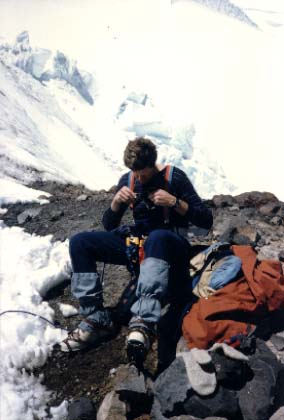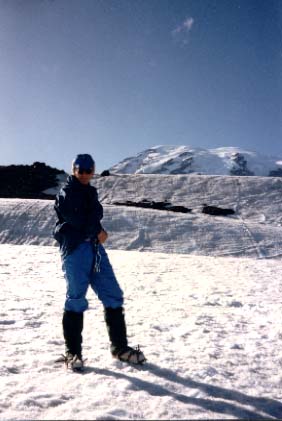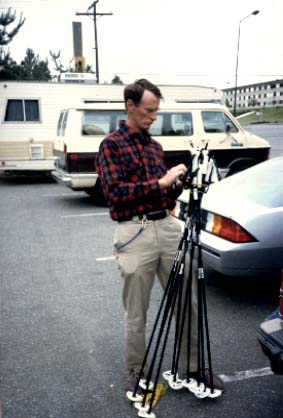Peter Stanley
Mt. McKinley
|
Peter Stanley Mt. McKinley |

|
The previous words were recorded on the summit and it is now the following morning down at Camp Muir -- a misnomer for a camp -- it's unlikely you can get as much as a cup of water here unless you melt your own snow, but it's a snow field at the 10,000 foot level where everyone gathers prior to the summit attempt if they're using the route of Disappointment Cleaver, which we took yesterday. My comments at the summit were brief partly because I was spent and partly because I wasn't sure that tape recorder was working. We rose at 3:00 a.m. yesterday and got off at 5:00, climbed basically to the summit from Camp Muir... approximately 4,400 feet. We'd climbed 5,000 feet the day before from Paradise. At 5:00 we took off and hiked for approximately one hour... our general hike times were about one hour... and after one hour we'd climbed about 1000 feet which we all felt was a pretty impressive rate of climb. There were several traverses underneath areas were avalanches were inevitable... they'd happen sooner or later. In addition, there were places we had to go across where warmth would have resulted in rocks falling and we could see where the rocks had fallen the previous day or in days past. And one of our reasons for an early departure was to try and reach the summit early enough and begin the descent prior to the sun's melting the snow and making it easier for either snow slides or rock falls to occur. At the beginning of the hike there was a pair of climbers who had left a half-hour or more before us, and we began to catch up with them in an area involving a lot of rock scree that was difficult to walk through... also the rocks were very unstable. The climbers yelled "Rocks!". Indeed, there were some coming down, productive of a great amount of adrenaline in my case as I sat there tied in and seeing the rocks falling and knowing there was no way I could get out of the way if any significant amount of rocks began to come. In the beginning I was not aware of the altitude change except to note that I was tired. The temperature was probably 15 degrees and at the beginning there was not much in the way of wind, but the wind began to build as we got higher. We walked across some pretty impressive crevasses. I wish I'd taken some pictures. I was afraid my camera wouldn't work. I should have tried it anyway - wish I had. But when you walk across a crevasse... there was none that involved more than a couple of feet from one lip to the next.... We knew that the lips were stable because there were footprints of other climbers who had gone before us, so we had at least some assurance that they were stable. When you look down into the abyss of the crevasse and realize what you are walking across and how unstable it really is, it can be a genuinely soul-throbbing experience. I think we had about four or five rests on the way to the summit, and the time the altitude really began to affect me was about 13,000 feet. At that point the wind really picked up - it must have gotten to about 40 miles per hour - not so much that we were in fear of being blown off or blown down, we were just buffeted heavily by the wind which required a lot of energy just to overcome - or it seemed so. The sun was out and very bright all the way. Without our sun goggles on even for an hour or two I think we would have been in great peril because I don't think our eyes would have lasted, or certainly mine wouldn't, being sensitive to sun anyway. It was as if there were no oxygen up there. There was plenty of air but no oxygen. The air was evidenced by the heavy blowing and the buffeting by the winds. And then as we approached the summit, Jeff Detweiler and his client from California who had preceded us came down. We had passed the group that had knocked some rocks down, and I don't think they ever made it to the summit. They looked very discouraged and dejected, I think, as we went by. They had to "heave to" and let us pass. But little by little we made our way on up beyond the 13,500 l4,000 foot mark. We rested about 600 feet beneath the lip which is a crater on Rainier; and at about, I would guess, 10:30 we heaved about the lip on what I think is the eastern side of the crater. We went on over and down into the crater and gave each other a few slaps on the back. But mostly we just lay down on the ground totally exhausted, and I recorded the little bit that was on this tape earlier. Larry, as we sat there said, "Well, crossing this lip represents completion of the climb of Rainier, but there is another peak over on the other side of the crater that's a little higher than this one." And then we looked at our map and decided that it was about a third of a mile across and maybe 200 feet higher. And somewhere from within our group came the will to cross and climb that final peak, even though it was not necessary for the record books. It certainly wasn't my idea. I would have been perfectly happy, I think... although I'm very glad we did it, I would have been perfectly happy at that point to take comfort and satisfaction from the technicality of having obtained the summit rather than actually having set foot on the absolute highest point. But I think it was Stuart or Matt who said, "Well, we might go on across and get up that final peak." The next thing I knew Larry had picked up his ice axe and Larry and I were going across and then Sam and then Matthew and Stuart. And pretty soon we were standing on top of the highest point (Columbia Crest, 14,400 feet) maybe twenty-five or thirty minutes later. There I took some pictures of Sam and Sam with his camera took some pictures of me looking - the background was Mt. St. Helens which has been smoking the whole time we have been climbing, and we have been hearing that there is a chance of an eruption. |



Go back to Peter Stanley